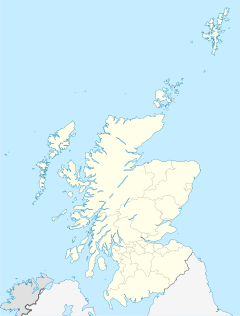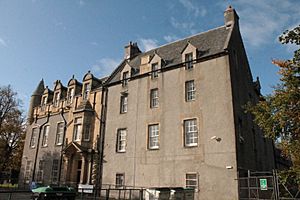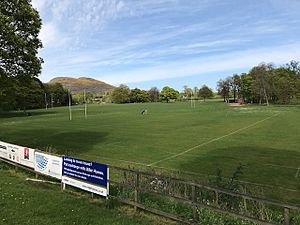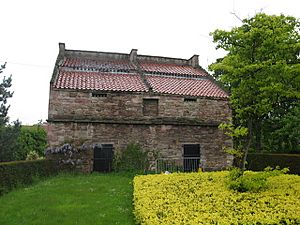The Inch, Edinburgh facts for kids
Quick facts for kids The Inch
|
|
|---|---|
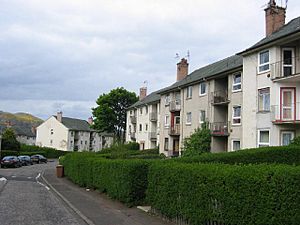 Examples of Inch housing |
|
| OS grid reference | NT279704 |
| Council area |
|
| Lieutenancy area | |
| Country | Scotland |
| Sovereign state | United Kingdom |
| Post town | Edinburgh |
| Postcode district | EH16 |
| Dialling code | 0131 |
| Ambulance | Scottish |
| EU Parliament | Scotland |
| UK Parliament |
|
| Scottish Parliament |
|
The Inch is a neighbourhood in Edinburgh, Scotland. It is located in the southern part of the city. The Inch is about 3 kilometres (2 miles) south-east of central Edinburgh. This area includes a housing development, a large park called Inch Park, and a historic building known as Inch House. Inch House is now a community centre. Close by, you can also find the Inch Doocot, which is an old pigeon house.
Contents
What's in a Name?
The name "Inch" comes from the Scottish Gaelic word innis. This word can mean either "island" or a dry area in a marsh or river meadow. This suggests that the land where The Inch stands was once a dry spot. It was likely surrounded by wetter ground near the Braid Burn river.
Building the Inch Community
The Inch housing area is bordered by Old Dalkeith Road to the east and Liberton Road to the west. Kingston Avenue is to the south, and Glenallan Drive and Inch Park are to the north.
How the Houses Were Designed
Building the houses started in 1949. The City of Edinburgh Council held a competition for architects to design the new homes. A young architect named David Stratton Davis, who was 29, won the competition.
Stratton based his design on the "Garden City" idea. This plan aimed to create a complete community. It would have homes, schools, churches, and shops. It was also important to have large green spaces nearby, like Inch Park. The design kept many old trees and added new ones. It also made sure there were nice views of places like Craigmillar Castle and the Pentland Hills.
The houses were built for different people, including families, older people, and single people. All the buildings were low, not tall. They had roofs made of slate, pantiles, or copper. The walls were a creamy colour. Each house had a garden and a drying area. By 1953, all the houses were lived in.
A Special Award for Design
In 1955, the Saltire Society gave The Inch a special award. They called it "the best designed local authority housing in Scotland." Today, many of these homes are owned by private families.
Street Names and Local Shops
Many streets in The Inch are named after characters and places from the books and poems of Sir Walter Scott. A newer part of the area has streets named after the poet Robert Burns.
There is a row of shops on Walter Scott Avenue, which is a main street. The local primary schools are Liberton Primary School and St. John Vianney Roman Catholic Primary School.
The Story of the Pillar Box
In November 1952, a new post box was put on Gilmerton Road. It was the first in Scotland to have the letters E II R on it. Some people were not happy about this. They felt that Queen Elizabeth was the first queen of that name to rule over Scotland. The post box was damaged in an incident in February 1953. The replacement post box then showed an image of the Crown of Scotland.
Inch House: A Historic Home
The Inch area grew up around Inch House. This old Scottish house was built in 1617. It is a very important historic building.
The City of Edinburgh Council bought the house in 1946. It was first used as a primary school. Later, it became a community centre for everyone to use.
Inch Park: Green Space for Sports
Inch Park used to be the private land around Inch House. Now, it is a public park for everyone. It has sports fields for rugby and football in winter. In summer, it is used for cricket. There is also a children's play area.
The Braid Burn river runs along the northern edge of the park. In 2010, work began to prevent flooding from the river.
Who Manages Inch Park?
The Gilmour family owned the park until 1946, when the City of Edinburgh Council took over. In 2009, a group called Inch Park Community Sports Club started managing the park. This club is a charity. It helps provide sports and fun activities for local clubs and the community. Three sports clubs work together at the park: Lismore Rugby Football Club, Edinburgh South Community Football Club, and Edinburgh South Cricket Club.
The Sports Club has an 80-year lease to manage the park. They received money from the City of Edinburgh Council and other groups to help them get started. The park has two rugby pitches, two football pitches, and a cricket oval. There is also a sports building with changing rooms, a cafe, and a meeting room.
Cricket at Inch Park
The Edinburgh South Cricket Club has three men's teams. They play in the East of Scotland Cricket Association league. There is also a Sunday team that plays friendly matches. The club also has sections for women and girls.
Football Fun at Inch Park
The Edinburgh South Community Football Club is a top-rated club by the Scottish Football Association. It has about 50 teams, with around 650 players. About 125 volunteers help as coaches and officials.
The club helps boys move from soccer school to playing senior football. They also have a similar program for girls.
Rugby at Inch Park
The Lismore Rugby Football Club started in 1901. They have played at Inch Park since 1953. The club has two men's teams and a women's team. It is also a registered charity.
Inch Plant Nursery
The Inch Nursery is a 10-acre site next to the park. It used to be the walled garden of Inch House. The City of Edinburgh Council owns it. The nursery grows most of the plants for the city's gardens and green spaces. It is also a place where people can train in gardening. There is a shop that sells plants to the public.
The Inch Doocot: A Pigeon House
This is the largest old pigeon house, or "doocot," left in Edinburgh. It is located on Gilmerton Road and is a very important historic building. It was built in the 1600s.
The doocot has two rooms made of sandstone. Each room has a wooden door and 16 holes for pigeons to fly in and out. Above the rooms, there is a special ledge to stop rats from climbing inside. The roof is made of pantiles. It is thought that there are about 2000 stone nesting boxes inside for pigeons.


